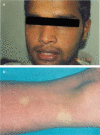Dengue infection: Global importance, immunopathology and management
- PMID: 35078789
- PMCID: PMC8813012
- DOI: 10.7861/clinmed.2021-0791
Dengue infection: Global importance, immunopathology and management
Abstract
Dengue is an arboviral infection that is hyperendemic in tropical and subtropical climates. Clinical manifestations of dengue can range from asymptomatic infection to severe infection with multi-organ failure. Dengue haemorrhagic fever (DHF) is a subcategory in dengue infection with a hallmark of plasma leak (ie critical phase). The plasma leak in DHF is selective (pleuroperitoneal spaces), transient and dynamic, and needs careful monitoring and meticulous fluid resuscitation. In addition, dengue fever may present with extended and unusual manifestations affecting any organ, including the heart, liver, kidney and brain. Studies on vaccine development and vector control are ongoing to prevent this infection of global importance. In this article, the clinicopathological features and management aspects of dengue are discussed.
Keywords: Aedes; Dengue haemorrhagic fever; NS1; critical phase; flavivirus; plasma leak.
© Royal College of Physicians 2022. All rights reserved.
Figures





References
-
- Roy SK, Bhattacharjee S. Dengue virus: epidemiology, biology, and disease aetiology. Can J Microbiol 2021;67:687–702. - PubMed
-
- Libraty DH, Young PR, Pickering D, et al. . High circulating levels of the dengue virus nonstructural protein NS1 early in dengue illness correlate with the development of dengue hemorrhagic fever. J Infect Dis 2002;186:1165–8. - PubMed
MeSH terms
LinkOut - more resources
Full Text Sources
Medical

